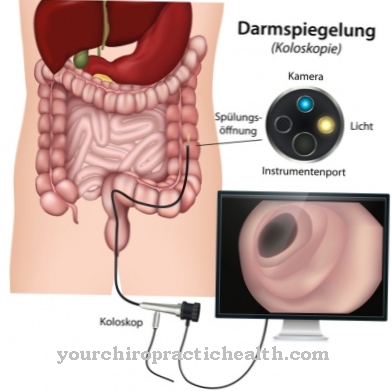The Ear, nose and throat medicine as a branch of medicine deals with diseases of the ear, nose and throat area. It includes the prevention, detection, treatment and aftercare of diseases of the ear, nose, mouth and upper airways. Treatment methods include both surgical, microsurgical, and drug procedures.
What is ear, nose and throat medicine?

Ear, nose and throat medicine (ENT medicine) is a special field of medicine that deals with the diagnosis and treatment of diseases, injuries, malformations and functional disorders of the ears, the oral cavity, the throat, the trachea, the larynx, the upper airways as well as the esophagus employed.
The abbreviation is found in English ENT Application, which means something like "Ears Nose and Throat". In the international professional world, this is what the name means ORL For Oto-rhino-laryngology. ENT medicine mainly uses the methods of scientific medicine. But naturopathic treatments are also used. Training to become a specialist in ENT medicine takes five years. After studying medicine, you need two years of basic training and then three years of specialist training in the field of ENT medicine. Compliance with the high scientific standards of ENT medicine is guaranteed by the German Society for Ear, Nose and Throat Medicine, Head and Neck Surgery.
This is an association of mainly scientifically active ENT doctors. The board of this society also includes a member of the German Professional Association of Ear, Nose and Throat Doctors. This professional association in turn consists of an association of practically active ENT doctors who have their own practice. It serves to exercise the rights of freelance ENT doctors vis-à-vis the health insurance companies and the Association of Statutory Health Insurance Physicians.
Treatments & therapies
In the context of ear, nose and throat medicine, various diseases, injuries, malformations or tumors of the ears, the nose, the paranasal sinuses, the oral cavity, the throat and functional disorders of the sensory organs in this area are examined and treated. The functional disorders include hearing, voice, speech and speech disorders.
Ear, nose and throat medicine is divided into several anatomical blocks such as ears, upper airways, lower airways and oral cavity. The anatomical block ears include the auricles, the ear lobes, the auditory canal, the middle ear and the inner ear. This block also includes central hearing pathways and hearing centers. Various infectious and non-infectious diseases are treated in the area of the ears. Examples are middle ear infections, childhood diseases such as mumps, general inflammation of the ear, tinnitus, hearing impairment, hearing loss or deafness.
Malformations and tumors in the ear area are also part of the treatment spectrum of ENT medicine. The upper airways consist of the nose, sinuses, nasopharynx, pharynx and tonsils. Particular diseases in this area are sinus infections, infections in the throat area, tonsillitis and many other infections. The lower airways are made up of the larynx and windpipe. Larynx cancer is a well-known disease in this area. The oral cavity is considered together with the tongue, the salivary glands and the tonsils. Inflammation of the mouth and throat can have many causes.
Infectious processes through bacteria, fungi or viruses as well as caustic or toxic substances or food that is too hot often play a role. Often, however, the ENT area is not the starting point of a disease, but is affected as part of another underlying health disorder. For this reason, there is an interdisciplinary collaboration between ear, nose and throat medicine and other medical specialties. There is overlap in particular in the fields of paediatrics, pediatric surgery, allergology, dermatology, neurology, oral and maxillofacial surgery, oral surgery and internal medicine with a focus on pneumology.
Diagnosis & examination methods
Ear, nose and throat medicine is a complex subject that has to deal with the diagnosis and treatment of many different diseases. For this reason, various examination methods are used depending on the disease.
In the case of mild and common infectious diseases of the upper respiratory tract, often only a medical history is required to determine the cause of the disease. Because many infections occur more frequently in certain times of the year and are transmitted via the air. However, if there is a chronic upper and lower airway disease, more intensive examinations must be carried out. Laboratory tests are carried out on smears from the mucous membrane of the mouth, from the tongue or from the throat. Possible pathogens are identified here. For a more detailed examination of the nose and sinuses, a so-called rhinoscopy is often performed.
This is a nasoscopy, in which a tiny camera with a light source is inserted into the nose on a cable and provides images of the nasal passages and the exits of the paranasal sinuses. In a posterior rhinoscopy, a mirror is passed over the oral cavity and throat into the posterior nasal passages for reflections. In the anterior nasoscopy, the anterior nasal passages are illuminated using a funnel with a headlamp. The air permeability of the nose can be checked with a nasal function test. The ear can also be examined with a headlamp attached to a funnel.
An ear microscope is used for more intensive examinations. A hearing test is used to test your hearing ability. The larynx can be examined using a stroboscope, for example. The vibrations of the vocal folds are made visible. Other examination methods also include neurootological examinations such as experimental nystagmus provocations or the functional examination of the neck-spine system. If allergies are suspected, non-specific and allergen-mediated provocation tests are used.
Sleep laboratories are available to investigate sleep apnea. In the context of ear, nose and throat medicine, imaging procedures such as X-ray examinations, ultrasound, MRI or CT are also used. Interdisciplinary cooperation with doctors from other specialist areas is often necessary for the diagnosis.













.jpg)

.jpg)
.jpg)











.jpg)